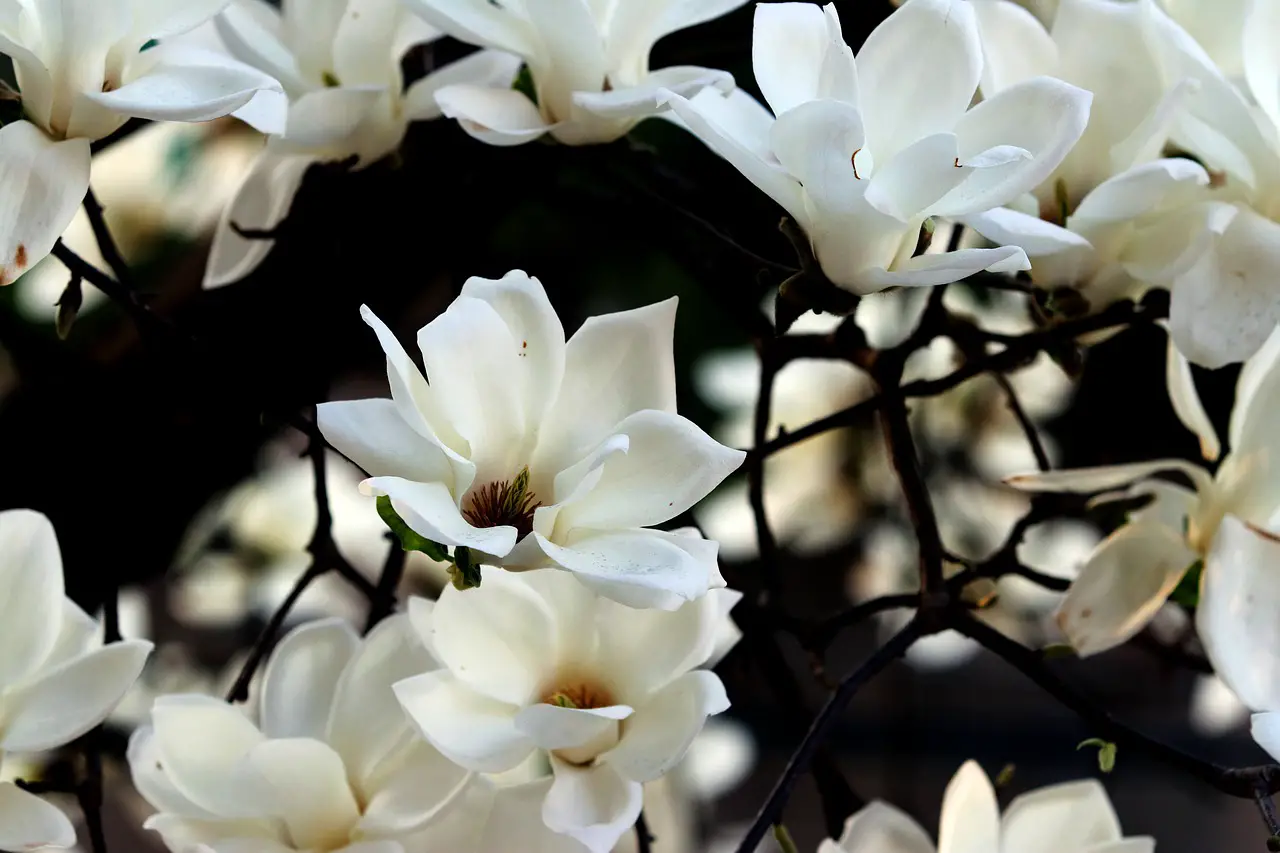Last Updated on April 3, 2024 by Real Men Sow
There are evergreen and deciduous Magnolias, however, deciduous Magnolias are more common in the UK. This is because they produce flowers when there are fewer leaves, which allows for the beauty of the flowers more clearly to be appreciated.

Things To Know About Magnolias Before Growing Them
- They thrive in full sun all year, but can also be grown in part shade. Low light conditions may cause the plant to stop producing flowers.
- Some varieties can be grown in containers.
- The height of the different varieties is 2.5m/8ft, with a spread 2.5m/8ft. It can go up to 20m/63ft in height and spread. You can choose the variety that best suits your space.
- They thrive in soil that is slightly acidic, or neutral. They don’t do well in alkaline, or chalky soils.
- These plants are very shallow-rooted and should not be allowed the soil to dry out. To prevent water loss, an annual mulch is strongly recommended.
- Magnolias can withstand neglect (with the exception of an annual mulch) once they are established. Their nutrient needs are low, and they thrive on minimal pruning.
- Every flower produces flowers, and some do so for several weeks depending on the local weather conditions.
- They shouldn’t be planted in frost pockets, or other areas susceptible to waterlogging.
- If they are not completely neglected, they rarely become infected or suffer from other diseases.
- They should be planted in a protected area. Wind can not only increase the frost effect but also cause damage to the branches.
Planting Magnolia
First, identify the right position. It is best to place your magnolia in full sunlight and away from easterly or northerly winds. Space is important. Don’t make your magnolia too small and give it enough room to grow.
When deciduous magnolias (which lose their leaves in winter) are dormant is the best time to plant them. This is between December and January. Dig the soil slightly deeper than the container to plant the new plant, and between 60cm and 90cm in width. Place the plant in a hole and cover it with the dug soil.
The roots of magnolias have shallow roots, so don’t pile soil higher than the base. Keep the soil moist and watered well for nine months, until the roots are established.
Taking Care of Magnolias
Once magnolias have been established, they require very little maintenance. Even though they can withstand neglect (other than lack of water), the following care plan will ensure their survival.
- An annual mulch made with well-rotted organic material such as compost heap or spent pot compost.
- You should water the plants well from the base. Keep mulches away from the stem.
- Your garden soil may become dry during summer. Water it well. Magnolia roots can dry out even if they are established and shallow.
How to Prune Magnolias
Pruning magnolias will not cause damage, but it will encourage wispy shoot growth that detracts from the shape. Pruning magnolias can cause their flowering to decrease for a few years. The rule of thumb for magnolias should be to not prune them unless they outgrow their space. It is best to prune magnolias in the early to mid-summer to avoid bleeding, which can lead to infection.
- Pruning should be spread over at least two, preferably three, years
- Remove diseased and crossed branches
- Keep the center of the magnolia visible
- Prune branches back to the main stem
Growing Magnolias In Containers
Magnolias can grow well in large containers. We recommend that you choose Magnolia stellata varieties. They are smaller than other magnolias, and the container will limit their size.
What is the Best Container for Magnolias?
For a few reasons, stone or terracotta is the best choice. Their weight, compared to lighter containers, will prevent them being blown over by strong winds. Containers that are large enough to support themselves should have a wide base.
Wood containers are very attractive and can be heavy. They may need treatment to stop the wood from rotting. This could also cause damage to your Magnolia. You should ensure that any container you use has drainage holes at the base.
Avoid round, bulbous pots with a narrower top than the base or middle. When it comes time to repot your Magnolia, the only way is to break the container.
The pot size should match the bush’s size. Usually, the best way to choose the right size container is to simply compare the pot’s size to the tree. As an example, a 45cm (18ins) square pot can support our 140cm tall magnolia quite well.
Repotting Magnolias
Magnolias can be replanted immediately after purchase or may grow out of their existing containers. Replanting a Magnolia tree in spring or late winter is the best time to do so. As described above, first choose a new container.
Next, you need to decide which soil you want. A slightly acidic soil is best for Magnolias. This means that potting compost suitable for Azaleas, Rhododendrons and other ericaceous plants will be appropriate. A loam-based compost that is slightly acidic is another option. John Innes sells an ericaceous mixture that is ideal, especially if it contains about 20% of sharp (not builder’s sand).
Clean the container if it has been previously used. To ensure drainage, add approximately 4 cm (1 1/2 inches) of smallish stones or broken pot pieces to the bottom of the container.
Take the tree out of its container and gently brush the soil from the roots and surface. You must be careful not to cause damage to the roots as they could easily snap. Then, add some compost to the container.
To ensure that the compost remains at the same level as the original container, it will be necessary to add and remove compost. Lightly firmen the new compost by adding it a few centimeters at a time. Do not compact the compost, but ensure that there are no air pockets.
To fill the container, add compost up to 5 cm / 2 in below the top. To the compost’s surface, add about 2cm/ 3/4in of chippings. A bag of chippings is a great way to finish off your compost and deter pests.
If possible, water well with rainwater (rather than tap water). Container supports are also recommended to keep the container from sinking into the ground. This allows for the best drainage and prevents the container from becoming a breeding ground for insects.
Taking Care of Magnolia in Containers
Although they don’t require much care, Magnolias appreciate care. It is important to ensure that the compost does not dry out. Even a few days without watering in warm sunny weather can cause them serious damage.
It is a good idea to ask your friends or neighbours to water your Magnolias if you are planning a summer holiday. If this is not possible, then place them in a cool and shaded area. If you live in an area that experiences cold winters or high winds, then keep your Magnolias in a cool garage or greenhouse until late December. Then bring them back to the garden in the early spring.
You can start feeding your tree with a general purpose fertilizer in May, at four-weekly intervals. Stop feeding the tree in July to allow it to “harden up” before winter.
A pruning in June is a good idea to remove any damaged or wispy branches, especially in the middle of the tree. To maintain the size and shape of a Magnolia, you can also prune it.
Winter Care for Container-grown Magnolias
Two main considerations should be made when caring for Magnolias in UK containers during winter. The first is to keep the soil dry from winter rain. Magnolias can tolerate many conditions, but they are not tolerant to large changes in water content.
As with all containerized plants, the second thing to be aware of is to prevent soil from freezing for long periods. Protracted frost can easily damage the Magnolia’s fleshy root system. Although it is possible to insulate containers, this will not prevent frost from occurring. Also, warmer temperatures can cause containers to take longer to defrost.
Keep the following two principles in mind when moving your Magnolia. A cold greenhouse is the best place for your Magnolia. This will provide protection against the cold winds and frost, as well as protecting your tree. This will protect your tree from the cooling winds and provide some protection against frost. However, it is important to take the greenhouse out of the greenhouse as soon as you feel the temperature rising. Even moderately warm temperatures can make greenhouses very hot.
Although most people don’t have a greenhouse, it is possible to grow a tree against an exterior wall of your house. After the frosts have passed, you can move the tree into the open.
You should not attempt to move the tree into your home if you don’t have a greenhouse or an open garage. The conditions will be too hot and the air too dry. It is best to locate the most protected spot near the house’s walls. The house walls are warm enough to protect your Magnolia tree from frost damage in winter. You should also look for a position that protects against wind and reduces rain on the soil.
Pests and Diseases
Slugs
Slugs that prefer to eat tender leaves can attack young magnolias. There are slug pellets available, but some are organic. You can pick them off by hand. After five years, a magnolia should be able to grow without slug attacks.
Rabbits
Rabbits are attracted to bark, and can eat large quantities of it with often fatal consequences. The only way to prevent damage is by using a barrier protection system that includes either a spiral tube around the lower stems, or a low-level wire mesh fencing.
Yellowing Leaves
Your soil may be too acidic, causing magnolia leaves to turn pale yellow. This makes it difficult for the plant to absorb essential nutrients. Use a fertilizer that is suitable for ericaceous plants, such as rhododendrons or azaleas, to feed the plant. Mulch the plant with an ericaceous soil every year.


